I. INTRODUCTION
The Sanctuary of Zeus, Mt. Lykaion, occupies Agios Elias, the second-highest peak of Mt. Lykaion (Figure 1). At an elevation of ~1360 m, the sanctuary is located ~14 km west of Megalopolis and ~33 km southeast of Olympia in the southern Peloponessos, Greece (Figure 2). The mountaintop summit itself is shaped like a dome, the base of which is a gently rolling bedrock surface that forms a kind of apron along the northern and western margins at an elevation of ~1170 m. Thus, when viewed from north or west, the dome appears to be projecting upward from a pedestal (Figure 3A). In contrast, the eastern margin of the mountaintop summit is a 200 m precipitous drop, strewn with landslides and rock falls. When viewed from the east, therefore, the Sanctuary of Zeus appears daunting and rather inaccessible (Figure 3B).
Figure 1. Summer storm on Mt. Lykaion
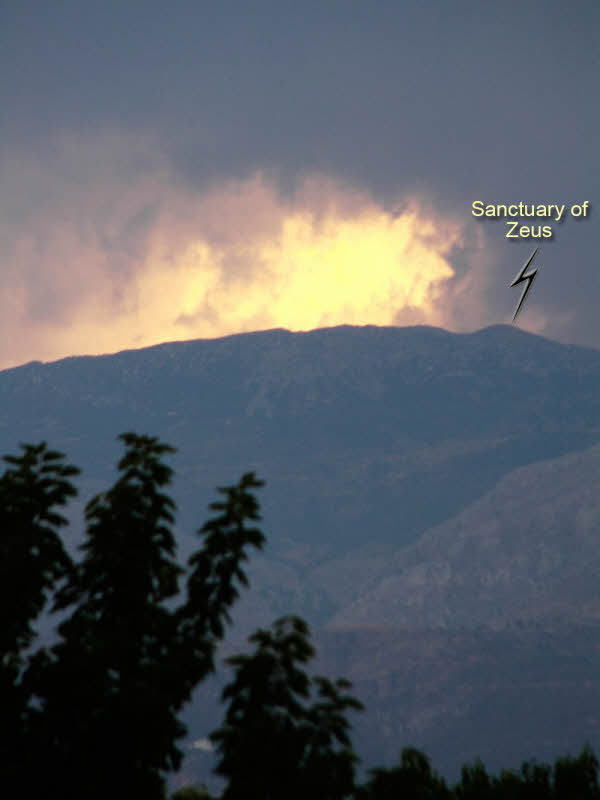
West-directed view of Mt. Lykaion from the city of Megalopolis. A summer storm is raging on the top of this mountain, where the Sanctuary of Zeus (“lightning wielder”) is located.
Figure 2. Location map of Mt. Lykaion
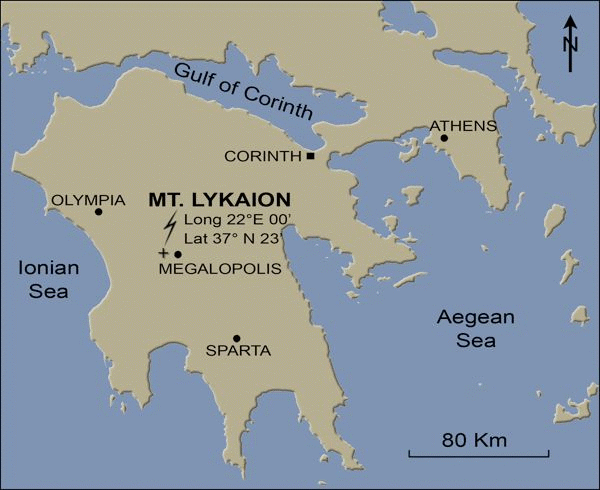
Location map showing the Sanctuary of Zeus, Mt. Lykaion, in Arcadia in the southern Peloponessos. It lies just 30 km southeast of Olympia.
Figure 3. Agios Elias
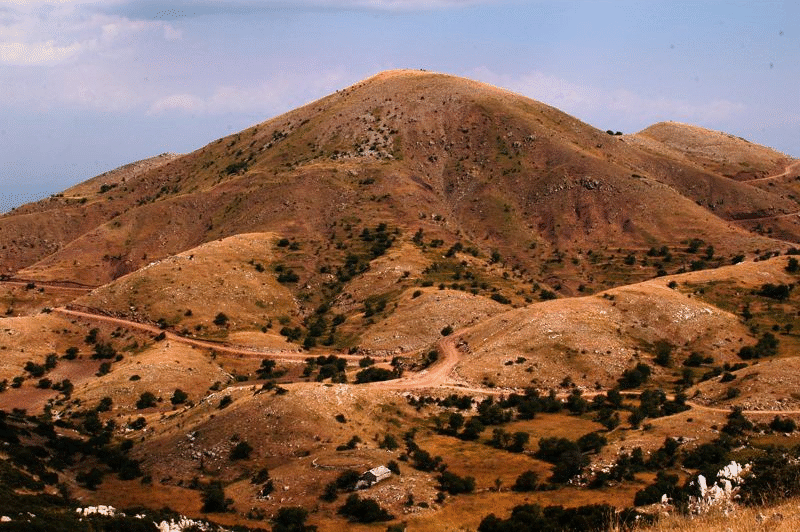
A. East-directed photograph of the Agios Elias summit of Mt. Lykaion. The ash altar to Zeus is located on the very crest of the summit. The clouds hovering above bring to mind epithets of Zeus, such as “cloud-gathering Zeus,” “Zeus the shepherd of the clouds,” “master of bright lightning,” “bright sky,” “bringer of the rain,” “bringer of storms,” “Zeus of the thunderbolt,” “Zeus of lightning,” and “Zeus furious and raging.” (David Romano, personal communication, 2008).
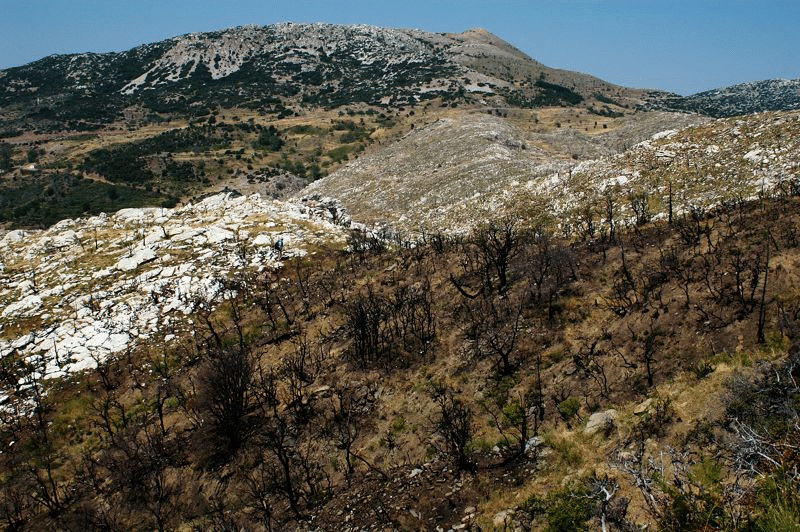
B. West-directed view of Mt. Lykaion, showing the steep, precipitous escarpment bounding Agios Elias on the east, and revealing rock falls, landslides, and structural terraces progressively stepped down eastward.
Pausanias, a Greek traveler and geographer of the 2nd century AD, provides us with an important glimpse of the Sanctuary of Zeus at Mt. Lykaion. He wrote a ten-book Description of Greece, including what he saw and learned about the ancient cultural geography while traveling in Arcadia. For example, Pausanias (8.38.5; 8.38.6; 8.38.7; see Frazer, 1913) makes specific reference to the Sanctuary of Zeus as a sacred place of pan-Hellenic significance, with stadium and hippodrome in which athletic games were held, a sanctuary of Pan, and a temenos and ash altar of Lykaion Zeus. The stadium and hippodrome lie within the lower part of the sanctuary on the flattish bedrock surface; the temenos and ash altar, in contrast, occupy the summit area of Agios Elias (Figure 4B). According to Pausanias (8.38.5; see Frazer, 1913): “There is on Mount Lykaion a sanctuary of Pan, and a grove of trees around it, with a hippodrome in front of which is a stadion (Figure 4A). Of old they used to hold here the Lykaion Games.” Further, Pausanias pointed out (8.38.7, 8.38.6; see Frazer, 1913): “On the highest point of the mountain is a mound of earth, forming an altar of Zeus Lykaios, and from it most of the Peloponessos can be seen” (Figure 4B). “...On this altar they sacrifice in secret to Lykaion Zeus;” adding (Pausanias, 8.38.6, see Frazer, 1913) “…on [Lykaios] is a temenos of Lykaion Zeus, into which people are not allowed to enter. If anyone takes no notice of the rule and enters, he must inevitably live no longer than a year” .
Figure 4. Hippodrome and ash altar
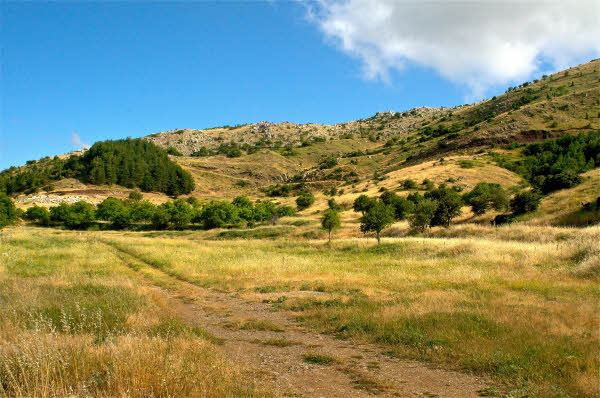
A. South-directed view of hippodrome (flat grassy area in foreground and middle ground). White limestone blocks and structures in far left in middle ground are part of stoa and fountain complex. Road slanting up to the right in background essentially follows Lykaion thrust fault.
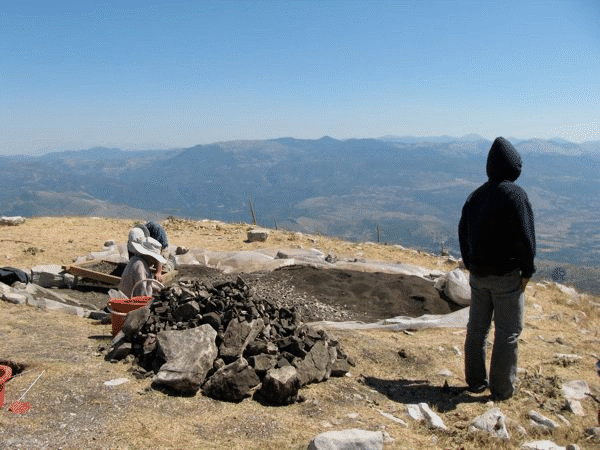
B. North-directed view showing ash altar (being excavated) on Agios Elias in the foreground and the view of the Peloponessos in the background.
It needs to be emphasized that the Sanctuary of Zeus on Agios Elias is truly a mountaintop sanctuary, and many of those who made the pilgrimage to the Sanctuary of Zeus experienced a long journey even before coming to the lower sanctuary. We know from a stone-slab (stela) record of the names of victors of the 304/03 B.C. Lykaion games that athletes hailed from long distances away from Mt. Lykaion, e.g., Macedonia, Syracuse, Rhodes, and broad reaches of Arcadia (Romano, 1997). Most may have come to Lykaion through Megalopolis, and ascended to the sanctuary from there. Megalopolis (see Figure 2) is located in a broad low basin created by active extensional faulting, one that for millions of years was a closed depression in which swampy conditions prevailed. Pausanias described Megalopolis as “gateway to the marsh;” today the city sits next to a gigantic open-pit lignite operation. Traveling from Megalopolis to the Lykaion summit required a walk of ~25 km and an ascent of more than 900 m, and this was ‘just’ the final chapter of the pilgrimage.